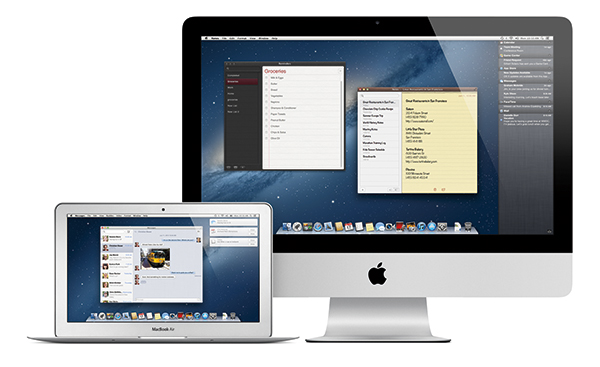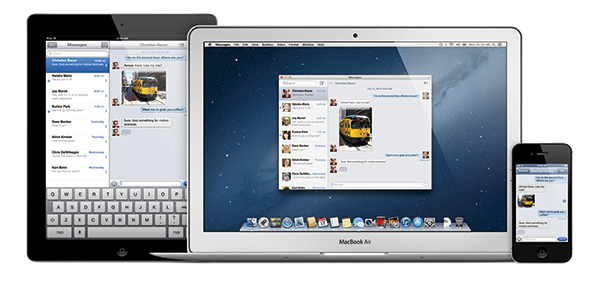While Apple’s Mountain Lion has been coolly waiting for its chance to pounce on Apple’s website, Craig Federighi announced at WWDC 2012’s opening Keynote that the next big cat will be available next month (no specific date given) for only $19.99 from the Mac App Store.
“With iCloud built right in and the new Notification Center, Messages, Dictation, Facebook integration and more, this is the best OS X yet.”
Mountain Lion brings OS X closer to iCloud thanks to a community of integrated apps and services that allow for seamless syncing of Mail, Notes, Reminders, Calendar events, Contacts, and Messages. In addition to these iCloud enabled apps and services (which we’ve long been familiar with), Apple is introducing Documents in the Cloud.
Documents in the Cloud is a new feature that integrates with Apple’s iWork suite and enabled third party apps to bring you documents that are stored in iCloud. In his demo, Federighi opened Pages which brought an iCloud-based document library. In Mountain Lion, Documents in the Cloud is enabled for Pages, Numbers, Keynote, Preview and TextEdit. The new document library browser provides a simple way to access recent documents no matter which device you access them from. Apple will be making available an SDK so developers can use this feature for their own apps.
Game Center, a brand new Safari with a unified search field, and AirPlay mirroring, and greater accessibility for China were also shown off. AirPlay mirroring lets you send up to a 1080p quality secure video stream or an audio stream to an AirPlay receiver as iOS devices can.
While we’re talking about applications, I should take the opportunity to say that Gatekeeper on the Mac is completely user controlled. Outed as a feature that protects you from bad guys (my words), users can decide whether or not to trust 3rd party applications from outside the Mac App Store. Gatekeeper itself will check for security updates in the background, and it provides kernel ASLR for protection against buffer overflow attacks. Overall, it’s a solid security update.
Mountain Lion itself has something aesthetic changes — a brand new glass dock is seated at the bottom of the display, and the Notification Center icon has changed from its preliminary circle to an icon representing a list of items in the menubar.
Notification Center received plenty of airtime, with service integration being demonstrated on stage. Notification Center is reminiscent of Growl, with banners sliding down from the upper right corner. Alerts stay on screen until you dismiss them, and additionally there’s an on / off switch for showing notifications. Notification Center is smart too — when connected to a project, the Notification Center will automatically shut off.
Given that you could dictate in iOS 5, it’s only right that the feature makes its way onto the Mac. Dictation really needs no explanation: “Anywhere you can type, you can now talk.”
Sharing in Mountain Lion is prevalent, with Twitter being used as the first example. Just like in iOS, a cute tweet sheet pops up that lets you quickly jot down your thoughts and send it off to share with your followers. Additionally, Facebook integration in OS X brings your friends and contacts closer than ever. Integrated in Mountain Lion just like with iOS 6, a single sign-in gives you access to share across a bevy of services including Twitter, Facebook, Flickr, and Vimeo. Facebook sharing lets you post to your wall, reply to a comment from an update displayed through the Notification Center, and directly update your Contacts with your friend’s information. To expound upon Notification Center, it displays updates from Twitter as well (for example, when someone mentions you in a tweet).
Power Nap is a feature we haven’t heard of before, letting your MacBook Pro with Retina Display or 2nd Gen (and above) MacBook Air receive data while it sleeps. All of the information you care about will be updated even before you open the lid — contacts, calendar events, emails, and other iCloud enabled services such as Find my Mac will work without user intervention. Even more amazing, your MacBook will be able to back up to Time Machine while in its Power Nap state. Supposedly, expected battery life should be maintained even when your MacBook is sipping power and downloading data while it’s asleep.
Customers who purchase one of Apple’s new MacBook Airs or MacBook Pros after June 11th will get a free update to Mountain Lion when it ships. Existing customers will be able to download it next month from the MAS. Today’s demo expounded what we already know, showcasing the rigidity of iCloud and new concepts that extends the Mac as an always active, lifestyle device. Mountain Lion’s integration with iCloud runs deep, and with over 1700 APIs available for developers, it’s a great release for developers and consumers alike.
Links
Mountain Lion Available in July From Mac App Store
SAN FRANCISCO–(BUSINESS WIRE)–Apple® today announced that OS X® Mountain Lion, the ninth major release of the world’s most advanced desktop operating system, will be available in July as a download from the Mac® App Store™. Mountain Lion introduces more than 200 innovative features including the all new Messages app, Notification Center, system-wide Sharing, Facebook integration*, Dictation, Power Nap, AirPlay® Mirroring, Game Center and the enhanced security of Gatekeeper. With iCloud® built into the foundation of OS X, Mountain Lion makes it easier than ever to keep your content up to date across all your devices.
“The pace of innovation on the Mac is amazing, OS X Mountain Lion comes just a year after the incredibly successful launch of Lion,” said Philip Schiller, Apple’s senior vice president of Worldwide Marketing. “With iCloud built right in and the new Notification Center, Messages, Dictation, Facebook integration and more, this is the best OS X yet.”
Using your iCloud account, Mountain Lion makes it easier than ever to set up your Mail, Contacts, Calendar, Messages, Reminders and Notes. The new Reminders and Notes apps help you remember important tasks and jot down your thoughts quickly, while iCloud automatically keeps everything up to date. Documents in the Cloud works with iCloud-enabled apps including Apple’s iWork® suite so you can always access and edit your documents on any device.
The new Messages app replaces iChat® and brings iMessage™ to the Mac, so you can send messages to anyone with an iPhone®, iPad®, iPod touch® or another Mac. You can include attachments, high quality photos and HD video, and your iMessages appear on all your devices so you can pick up a conversation right where you left off. iMessage includes group messaging, delivery and read receipts, typing indicators and secure end-to-end encryption. The Messages app also supports traditional instant messaging services, including AIM, Yahoo!, Google Talk and Jabber.
Mountain Lion streamlines the presentation of notifications, and with Notification Center you can see all your notifications from OS X and third party apps in one convenient place. You can customize which apps send you notifications, the type of notification you receive, and how many items are shown in Notification Center. When you want to focus on your work or watch a movie, you can choose to temporarily suspend all notifications.
New system-wide Sharing is built into Mountain Lion, making it easier than ever to share links, photos, videos and other files. Clicking the Share button allows you to share quickly without having to switch to another app, and you just need to sign in once to use third-party services like Facebook, Twitter, Flickr and Vimeo. Facebook and Twitter are integrated with Notification Center so you can receive notifications when someone sends you a message or mentions you in a post or Tweet.
With built-in support for Facebook, you can post photos, links and comments with locations right from your apps. Once you’ve signed in, your Facebook friends automatically appear in Contacts with their profile photos. Your Facebook notifications work with Notification Center in Mountain Lion, and you can even update your Facebook status from within Notification Center.
Dictation is built into Mountain Lion and allows you to dictate text anywhere you can type, whether you’re using an app from Apple or a third party developer. Mountain Lion also introduces Power Nap, an innovative new feature that keeps your MacBook Pro with Retina™ display and MacBook Air (second and third generation) up to date while it sleeps. Power Nap automatically refreshes Mail, Contacts, Calendar, Reminders, Notes, Photo Stream, Find My Mac and Documents in the Cloud, and when plugged in, downloads software updates and backs up your Mac using Time Machine®.
The revolutionary new Gatekeeper feature makes downloading software from the Internet safer by giving you control over which apps can be installed on your Mac. You can choose to install apps from anywhere, just as you do today, or for maximum security you can set Gatekeeper to allow only apps from the Mac App Store. The default setting allows you to install apps from the Mac App Store and apps from developers that have a unique Developer ID from Apple. In addition to checking daily for security updates, Mountain Lion includes app sandboxing to keep misbehaving apps from compromising your system, and kernel ASLR for improved protection against buffer overflow attacks.
Additional new features in Mountain Lion include:
• AirPlay Mirroring, an easy way to wirelessly send an up-to-1080p secure stream of what’s on your Mac to an HDTV using Apple TV®, or send audio to a receiver or speakers that use AirPlay;
• Game Center, which brings the popular social gaming network from iOS to the Mac so you can enjoy live, multiplayer games with friends whether they’re on a Mac, iPhone, iPad or iPod touch;
• a faster Safari® with a unified Smart Search Field, iCloud Tabs that present your open tabs across your devices, and a new Tab View to quickly swipe through them;
• new features for China, including significantly improved text input, a new Chinese Dictionary, easy setup with popular email providers, Baidu search in Safari, built-in sharing to Sina Weibo and popular video websites Youku and Tudou; and
• over 1,700 new APIs that give developers access to the latest core OS and web technologies, as well as the newest features of OS X, including Documents in the Cloud, Notifications, Sharing and Game Center.
Pricing & Availability
OS X Mountain Lion will be available in July from the Mac App Store for $19.99 (US). Mountain Lion requires Lion or Snow Leopard (OS X v10.6.8 or later), 2GB of memory and 8GB of available space. For a complete list of system requirements and compatible systems, please visit: apple.com/osx/specs/. OS X Server requires Mountain Lion and will be available in July from the Mac App Store for $19.99 (US). The OS X Mountain Lion Up-to-Date upgrade is available at no additional charge via the Mac App Store to all customers who purchased a qualifying new Mac system from Apple or an Apple Authorized Reseller on or after June 11, 2012.
*Facebook integration will be available in an upcoming software update to Mountain Lion.
Apple designs Macs, the best personal computers in the world, along with OS X, iLife, iWork and professional software. Apple leads the digital music revolution with its iPods and iTunes online store. Apple has reinvented the mobile phone with its revolutionary iPhone and App Store, and is defining the future of mobile media and computing devices with iPad.
NOTE TO EDITORS: For additional information visit Apple’s PR website (apple.com/pr), or call Apple’s Media Helpline at (408) 974-2042.
© 2012 Apple Inc. All rights reserved. Apple, the Apple logo, Mac, Mac OS, Macintosh, OS X, App Store, AirPlay, iCloud, iWork, iChat, iMessage, iPhone, iPad, iPod touch, Retina, Time Machine, Apple TV and Safari are trademarks of Apple. Other company and product names may be trademarks of their respective owners.
Apple
Bill Evans, 408-974-0610
[email protected]
Monica Sarkar, 408-862-3204
[email protected]







